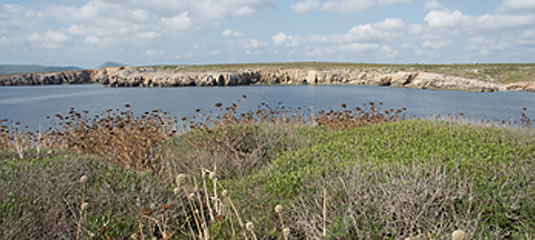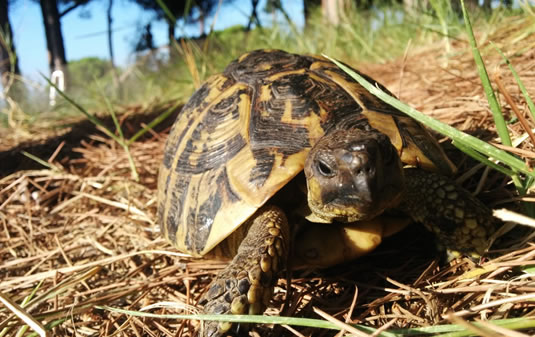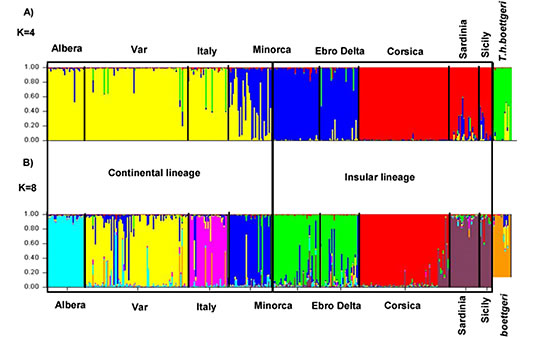THE RECENT DIVERSIFICATION OF THE BALEARIC LIZARD PODARCIS LILFORDI
The recent allopatric radiation of Podarcis lilfordi in the Balearic Islands provides a wonderful underexplored system to understand the early steps of phenotypic diversification and incipient speciation.
In the Menorcan coastal islets, 15 populations originated from a single ancestral population inhabiting the main Menorca Island and have been geographically and reproductively isolated for at least the past 2000 years, providing natural replicates of approximate mesocosms. Despite their recent segregation, these populations show clear differences in size, morphology, pigmentation and trophic ecological traits, as a result of both repeated bottlenecks (drift) and local adaptation.
We aim at using this powerful natural system to explore changes in life history traits, morphology and genomes to gain a comprehensive understanding of the early forces driving animal diversification.
Currently, we are attempting to reconstruct the phylogeography of these populations using a combination of geological data and microsatellites genome markers from an extensive sampling encompassing more than 600 specimens. The phylogepgraphic history will be used as a framework to test eco-evolutionary hypotheses.

View from Tosqueta islet

The unique melanic form of P. lilfordi from the islet Aire.
PALEODEMOGRAPHY AND LIFE HISTORY VARIATION OF THE MEDITERRANEAN TORTOISE TESTUDO HERMANNI
Low dispersal species with populations under contrasting ecological interactions offer valuable system to test eco-evolutionary hypotheses. This is the case of insular vs continental populations of the Mediterranean tortoise, with supposed distinct life history strategies due to the absence or presence of predators, respectively.
Two haplotypes, historically separated, have been introduced into the Balearic Islands. One, called haplotype H3, has a continental origin, with natural representatives coming from the Iberian Peninsula; the other one, called H5, has an insular origin, with closest relatives coming from natural populations of the Thyrrenian islands.
The first introduction matches the first settlement of man on Balearic Islands some millennia ago, and dates the arrival of H5 insular haplotype from East. The second introduction occurred at the beginning of the last millennia with the occupation of the Islands by Catalans and dates the arrival of H3 haplotype.
Life History variation
The presence of both haplotypes with a still unmixed distribution within the Balearic Islands provides a natural Common Garden Experiment to study the evolution of life history strategies
Specifically, ongoing research aims to explore differences in:
- Growth rates
- Age of sexual maturation
- Adult maximum size
- Shell morphology
We compare these traits across populations as a function of both genetic constraints and environmental adaptation.
Growth rates are derived from annual rings and a long-term mark-recapture program. Adult size differences are being predicted from combined effects on rates of growth and maturation, while adult shell shape differences between haplotypes are modeled by geometric morphometrics.
Our final scope is to derive a demographic-evolutionary scenario of size and shape influence on the life table and evaluating the fitness elasticity involved.
Recent articles on the topic:
- Zenboudji, S.; et al. 2016. Conservation of the endangered Mediterranean tortoise Testudo hermanni hermanni: the contribution of population genetics and historical demography. Biological Conservation 195:279-291. DOI: 10.1016/j.biocon.2016.01.007
- Bertolero, A.; Pretus,J.L.; Oro,D. 2018. The importance of including survival release costs when assessing viability in reptile translocations. Biological Conservation 217:311-320. DOI: 10.1016/j.biocon.2017.11.023

Testudo hermanni hermanni is a threatened species with slightly differentiated local populations having life histories fitted to their particular age-survival schedules. These genetic responses overlap with additional variation due to phenotypic plasticity in response to differences in habitat quality

Genetic groups assigned by program Structure based on 17 microsatellite loci (from Zenboudji et al., 2016)
